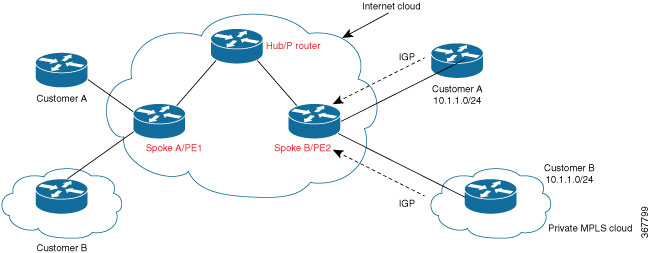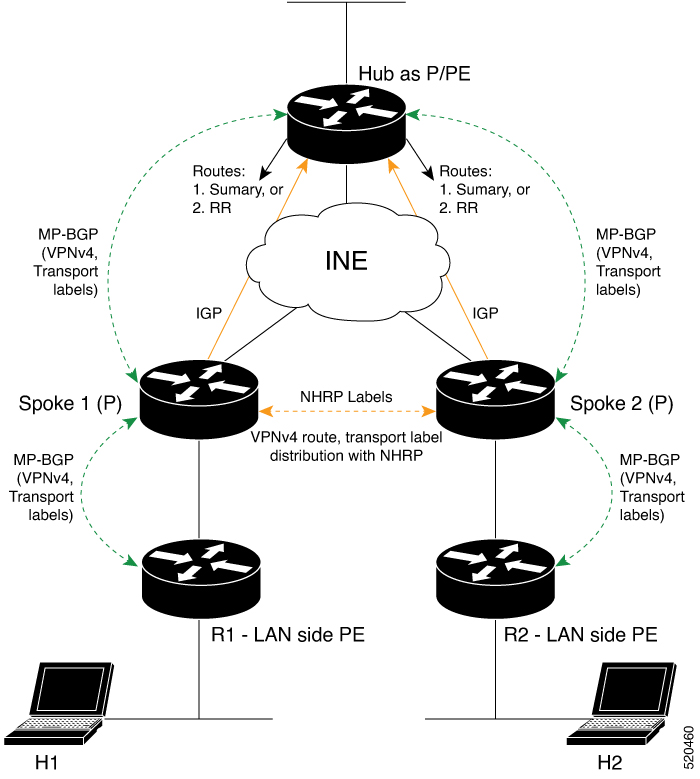Example: MPLS over DMVPN - Using MPLS
The following is the configuration on Spoke 1:
hostname R3-Spoke
!
boot-start-marker
boot-end-marker
!
!
vrf definition cust1
rd 1:1
route-target export 1:1
route-target import 1:1
!
address-family ipv4
exit-address-family
!
vrf definition cust2
rd 2:2
route-target export 2:2
route-target import 2:2
!
address-family ipv4
exit-address-family
!
clock timezone CET 1 0
!
no ip domain lookup
ip domain name cisco.com
ip cef
no ipv6 cef
mpls ldp loop-detection
!
crypto pki trustpoint CA
enrollment url http://172.16.1.1:80
password
fingerprint E0AFEFD7F08070BAB33C8297C97E6457
subject-name cn=R3-spoke.cisco.com,OU=FLEX,O=Cisco
revocation-check crl none
!
crypto pki certificate map mymap 10
subject-name co ou = flex
!
crypto pki certificate chain CA
certificate 03
certificate ca 01
crypto ikev2 authorization policy default
route set interface
!
crypto ikev2 profile default
match certificate mymap
identity local fqdn R3-Spoke.cisco.com
authentication local rsa-sig
authentication remote rsa-sig
pki trustpoint CA
dpd 60 2 on-demand
aaa authorization group cert list default default
!
!
!
!
crypto ipsec profile default
set ikev2-profile default
!
!
!
!
!
!
interface Tunnel0
ip address negotiated
ip nhrp map multicast
ip nhrp map
ip nhrp nhs
mpls bgp forwarding
tunnel source Ethernet0/0
tunnel destination 172.16.0.1
tunnel protection ipsec profile default
!
interface Ethernet0/0
description WAN
ip address 172.16.1.103 255.255.255.0
!
interface Ethernet0/1
description LAN
no ip address
no ip unreachables
!
interface Ethernet0/1.10
encapsulation dot1Q 10
vrf forwarding cust1
ip address 192.168.113.1 255.255.255.0
!
interface Ethernet0/1.20
encapsulation dot1Q 20
vrf forwarding cust2
ip address 192.168.123.1 255.255.255.0
!
router bgp 100
bgp log-neighbor-changes
neighbor 10.0.0.1 remote-as 10
neighbor 10.0.0.1 ebgp-multihop 255
neighbor 10.0.0.1 update-source Tunnel0
!
address-family ipv4
neighbor 10.0.0.1 activate
exit-address-family
!
address-family vpnv4
neighbor 10.0.0.1 activate
neighbor 10.0.0.1 send-community both
exit-address-family
!
address-family ipv4 vrf cust1
redistribute connected
exit-address-family
!
address-family ipv4 vrf cust2
redistribute connected
exit-address-family
!
ip route 10.0.0.1 255.255.255.255 Tunnel0 name workaround
ip route 172.16.0.1 255.255.255.255 172.16.1.1 name FlexHUB
The following is the configuration on Spoke B.
hostname R4-Spoke
!
vrf definition cust1
rd 1:1
route-target export 1:1
route-target import 1:1
!
address-family ipv4
exit-address-family
!
vrf definition cust2
rd 2:2
route-target export 2:2
route-target import 2:2
!
address-family ipv4
exit-address-family
!
clock timezone CET 1 0
!
no ip domain lookup
ip domain name cisco.com
ip cef
no ipv6 cef
!
crypto pki token default removal timeout 0
!
crypto pki trustpoint CA
enrollment url http://172.16.1.1:80
password
fingerprint E0AFEFD7F08070BAB33C8297C97E6457
subject-name cn=R4-Spoke.cisco.com,OU=Flex,O=Cisco
revocation-check crl none
!
crypto pki certificate map mymap 10
subject-name co ou = flex
!
crypto pki certificate chain CA
certificate 04
certificate ca 01
!
crypto ikev2 authorization policy default
route set interface
!
crypto ikev2 profile default
match certificate mymap
identity local fqdn R4.cisco.com
authentication local rsa-sig
authentication remote rsa-sig
pki trustpoint CA
dpd 60 2 on-demand
aaa authorization group cert list default default
virtual-template 1
!
crypto ipsec profile default
set ikev2-profile default
!
interface Loopback100
vrf forwarding cust1
ip address 192.168.114.1 255.255.255.0
!
interface Loopback101
vrf forwarding cust2
ip address 192.168.124.1 255.255.255.0
!
interface Tunnel0
ip address negotiated
mpls bgp forwarding
tunnel source Ethernet0/0
tunnel destination 172.16.0.1
tunnel protection ipsec profile default
!
interface Ethernet0/0
description WAN
ip address 172.16.1.104 255.255.255.0
!
interface Ethernet0/1
description LAN
ip address 192.168.104.1 255.255.255.0
!
router bgp 100
bgp log-neighbor-changes
neighbor 10.0.0.1 remote-as 10
neighbor 10.0.0.1 ebgp-multihop 255
neighbor 10.0.0.1 update-source Tunnel0
!
address-family ipv4
neighbor 10.0.0.1 activate
exit-address-family
!
address-family vpnv4
neighbor 10.0.0.1 activate
neighbor 10.0.0.1 send-community both
exit-address-family
!
address-family ipv4 vrf cust1
redistribute connected
exit-address-family
!
address-family ipv4 vrf cust2
redistribute connected
exit-address-family
!
ip route 10.0.0.1 255.255.255.255 Tunnel0
ip route 172.16.0.1 255.255.255.255 172.16.1.1 name FlexHUB
The hub configuration is as follows:
hostname R1-HUB
aaa new-model
!
!
aaa authorization network default local
!
!
clock timezone CET 1 0
!
ip vrf cust1
rd 1:1
route-target export 1:1
route-target import 1:1
!
ip vrf cust2
rd 2:2
route-target export 2:2
route-target import 2:2
!
no ip domain lookup
ip domain name cisco.com
ip cef
no ipv6 cef
!
multilink bundle-name authenticated
mpls ldp loop-detection
!
crypto pki trustpoint CA
enrollment url http://172.16.0.2:80
password
fingerprint E0AFEFD7F08070BAB33C8297C97E6457
subject-name CN=R1-HUB.cisco.com,OU=FLEX,OU=VPN,O=Cisco Systems,C=US,L=Linux
revocation-check crl none
rsakeypair R1-HUB.cisco.com 2048
auto-enroll 95
!
!
crypto pki certificate chain CA
certificate 02
certificate ca 01
!
redundancy
!
!
!
crypto ikev2 authorization policy default
pool mypool
banner ^C Welcome ^C
def-domain cisco.com
!
!
!
!
crypto ikev2 profile default
match identity remote fqdn domain cisco.com
identity local dn
authentication local rsa-sig
authentication remote rsa-sig
pki trustpoint CA
dpd 60 2 on-demand
aaa authorization group cert list default default
virtual-template 1
!
crypto ipsec profile default
set ikev2-profile default
!
!
!
!
!
!
interface Loopback0
description VT source interface
ip address 10.0.0.1 255.255.255.255
!
interface Ethernet0/0
description WAN
ip address 172.16.0.1 255.255.255.252
!
interface Ethernet0/1
description LAN
ip address 192.168.100.1 255.255.255.0
!
interface Ethernet0/2
ip vrf forwarding cust1
ip address 192.168.110.1 255.255.255.0
!
interface Ethernet0/3
ip vrf forwarding cust2
ip address 192.168.111.1 255.255.255.0
!
interface Virtual-Template1 type tunnel
ip unnumbered Loopback0
ip nhrp network-id 1
ip nhrp redirect
mpls bgp forwarding
tunnel protection ipsec profile default
!
router bgp 10
bgp log-neighbor-changes
bgp listen range 0.0.0.0/0 peer-group mpls
bgp listen limit 5000
neighbor mpls peer-group
neighbor mpls remote-as 100
neighbor mpls transport connection-mode passive
neighbor mpls update-source Loopback0
!
address-family ipv4
redistribute static route-map global
neighbor mpls activate
neighbor mpls next-hop-self
exit-address-family
!
address-family vpnv4
neighbor mpls activate
neighbor mpls send-community both
exit-address-family
!
address-family ipv4 vrf cust1
redistribute connected
redistribute static route-map cust1
default-information originate
exit-address-family
!
address-family ipv4 vrf cust2
redistribute connected
redistribute static route-map cust2
default-information originate
exit-address-family
!
ip local pool mypool 10.1.1.1 10.1.1.254
ip forward-protocol nd
!
!
no ip http server
no ip http secure-server
ip route 0.0.0.0 0.0.0.0 172.16.0.2 name route_to_internet
ip route vrf cust1 0.0.0.0 0.0.0.0 Null0 tag 666 name default_originate
ip route vrf cust2 0.0.0.0 0.0.0.0 Null0 tag 667 name default_originate
!
route-map cust1 permit 10
match tag 666
!
route-map cust2 permit 10
match tag 667
The following is the spoke output:
R4-Spoke# show ip cef vrf cust1 192.168.110.1
192.168.110.0/24, epoch 0, flags rib defined all labels, RIB[B], refcount 5, per-destination sharing
sources: RIB
feature space:
IPRM: 0x00018000
LFD: 192.168.110.0/24 0 local labels
contains path extension list
ifnums: (none)
path EF36CA28, path list EF36DEB4, share 1/1, type recursive, for IPv4, flags must-be-labelled
MPLS short path extensions: MOI flags = 0x0 label 19
recursive via 10.0.0.1[IPv4:Default] label 19, fib F0C5926C, 1 terminal fib, v4:Default:10.0.0.1/32
path EF36CBE8, path list EF36DFF4, share 1/1, type attached host, for IPv4
MPLS short path extensions: MOI flags = 0x1 label implicit-null
attached to Tunnel0, adjacency IP midchain out of Tunnel0 F0481718
output chain: label 19 label implicit-null TAG midchain out of Tunnel0 F1D97A90 IP adj out of Ethernet0/0, addr 172.16.1.1 F0481848
R4-Spoke# show ip bgp vpnv4 all label
Network Next Hop In label/Out label
Route Distinguisher: 1:1 (cust1)
0.0.0.0 10.0.0.1 nolabel/18
192.168.110.0 10.0.0.1 nolabel/19
192.168.114.0 0.0.0.0 16/nolabel(cust1)
Route Distinguisher: 2:2 (cust2)
0.0.0.0 10.0.0.1 nolabel/20
192.168.111.0 10.0.0.1 nolabel/21
192.168.124.0 0.0.0.0 17/nolabel(cust2)
The following is the hub output:
R1-HUB# show ip cef vrf cust1 192.168.113.1 in
192.168.113.0/24, epoch 0, flags rib defined all labels, RIB[B], refcount 5, per-destination sharing
sources: RIB, LTE
feature space:
IPRM: 0x00018000
LFD: 192.168.113.0/24 1 local label
local label info: other/25
contains path extension list
disposition chain 0xF1E1D9B0
label switch chain 0xF1E1D9B0
ifnums: (none)
path F16ECA10, path list F16EDFBC, share 1/1, type recursive, for IPv4, flags must-be-labelled
MPLS short path extensions: MOI flags = 0x0 label 16
recursive via 10.1.1.3[IPv4:Default] label 16, fib F0CCD6E8, 1 terminal fib, v4:Default:10.1.1.3/32
path F16ECE00, path list F16EE28C, share 1/1, type attached host, for IPv4
MPLS short path extensions: MOI flags = 0x1 label implicit-null
attached to Virtual-Access1, adjacency IP midchain out of Virtual-Access1 F04F35D8
output chain: label 16 label implicit-null TAG midchain out of Virtual-Access1 F1E1DF60 IP adj out of Ethernet0/0, addr 172.16.0.2 F04F3708
R1-HUB#sh ip bgp vpnv4 all
BGP table version is 49, local router ID is 10.0.0.1
Status codes: s suppressed, d damped, h history, * valid, > best, i - internal,
r RIB-failure, S Stale, m multipath, b backup-path, x best-external, f RT-Filter, a additional-path
Origin codes: i - IGP, e - EGP, ? - incomplete
Network Next Hop Metric LocPrf Weight Path
Route Distinguisher: 1:1 (default for vrf cust1)
*> 0.0.0.0 0.0.0.0 0 32768 ?
*> 192.168.110.0 0.0.0.0 0 32768 ?
*> 192.168.113.0 10.1.1.3 0 0 100 ?
*> 192.168.114.0 10.1.1.4 0 0 100 ?
Route Distinguisher: 2:2 (default for vrf cust2)
*> 0.0.0.0 0.0.0.0 0 32768 ?
*> 192.168.111.0 0.0.0.0 0 32768 ?
*> 192.168.123.0 10.1.1.3 0 0 100 ?
*> 192.168.124.0 10.1.1.4 0 0 100 ?
R1-HUB# show ip bgp vpnv4 all 192.168.113.1
BGP routing table entry for 1:1:192.168.113.0/24, version 48
Paths: (1 available, best #1, table cust1)
Advertised to update-groups:
3
Refresh Epoch 1
100
10.1.1.3 from *10.1.1.3 (172.16.1.103)
Origin incomplete, metric 0, localpref 100, valid, external, best
Extended Community: RT:1:1
mpls labels in/out 25/16
BGP routing table entry for 2:2:0.0.0.0/0, version 8
Paths: (1 available, best #1, table cust2)
Advertised to update-groups:
3
Refresh Epoch 1
Local
0.0.0.0 from 0.0.0.0 (10.0.0.1)
Origin incomplete, metric 0, localpref 100, weight 32768, valid, sourced, best
Extended Community: RT:2:2
mpls labels in/out 20/aggregate(cust2)
The following example shows how to configure NHRP redirect interest on tunnel interface:
!
router nhrp 101
address-family ipv4 vrf A
network 1.1.1.1 0.0.0.255
nhrp redirect interest aclname
exit-address-family
!
!
router nhrp 101
address-family ipv4 vrf A
network 1.1.1.1 0.0.0.255
nhrp redirect interest 2
exit-address-family
!




 Feedback
Feedback